University Research Proposal: Cloud Computing in Business, Analysis
VerifiedAdded on 2020/03/02
|17
|3096
|63
Project
AI Summary
This research proposal examines the advantages and disadvantages of cloud computing for businesses. It begins with an introduction to cloud computing, its characteristics, and service models (SaaS, PaaS, IaaS). The study aims to identify and analyze the benefits (flexibility, collaboration, automatic updates, security) and limitations (data stealing, malware attacks, DoS attacks) of cloud computing in business. The methodology includes a positivism research philosophy, a deductive approach, and a descriptive research design. Data will be collected through online surveys and secondary sources. The proposal highlights the importance of understanding cloud computing's impact on business operations, security concerns, and the need for effective cost management. The study seeks to provide recommendations for overcoming the challenges associated with cloud computing adoption and usage. The proposal covers the rationale, aims, objectives, research questions, and problem statement related to cloud computing in business.
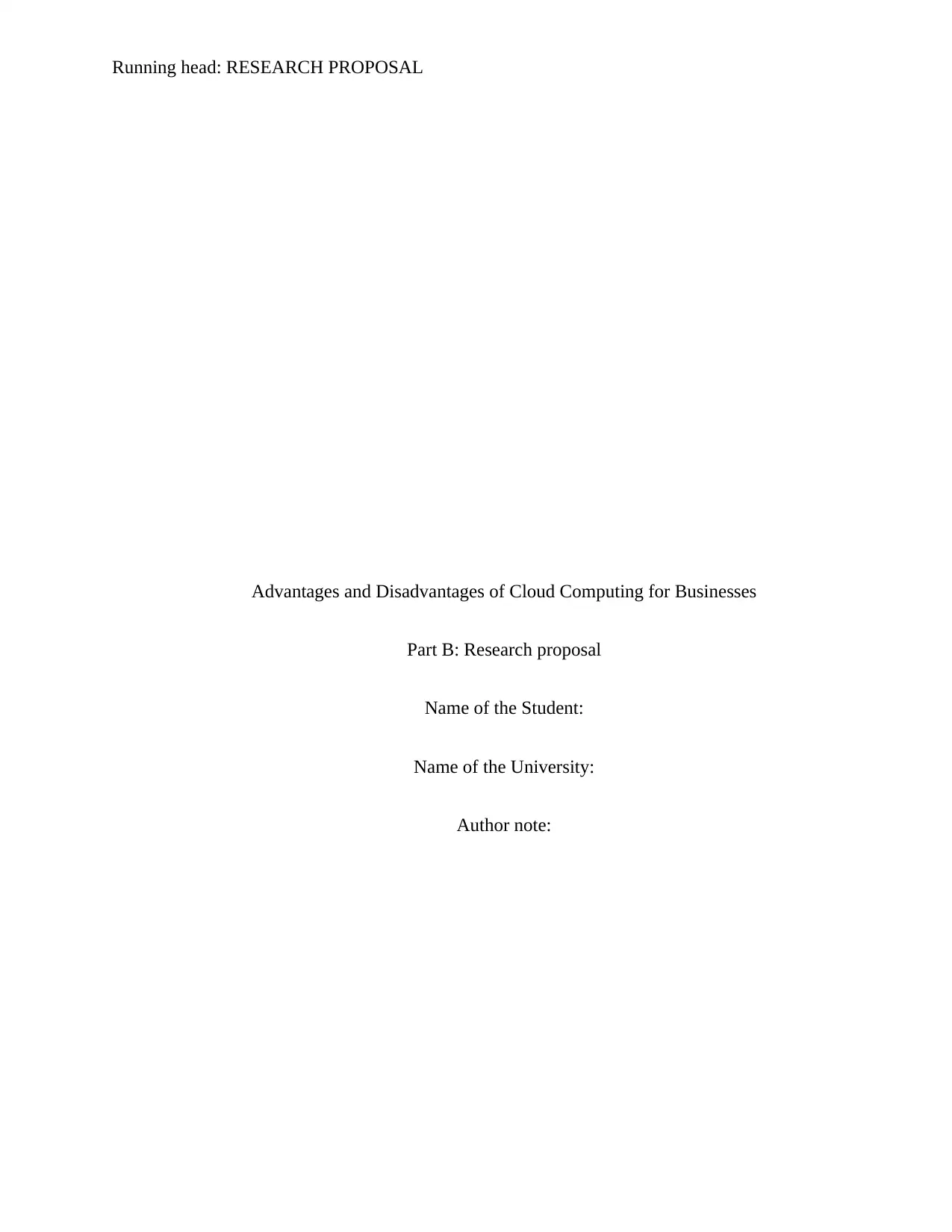
Running head: RESEARCH PROPOSAL
Advantages and Disadvantages of Cloud Computing for Businesses
Part B: Research proposal
Name of the Student:
Name of the University:
Author note:
Advantages and Disadvantages of Cloud Computing for Businesses
Part B: Research proposal
Name of the Student:
Name of the University:
Author note:
Paraphrase This Document
Need a fresh take? Get an instant paraphrase of this document with our AI Paraphraser
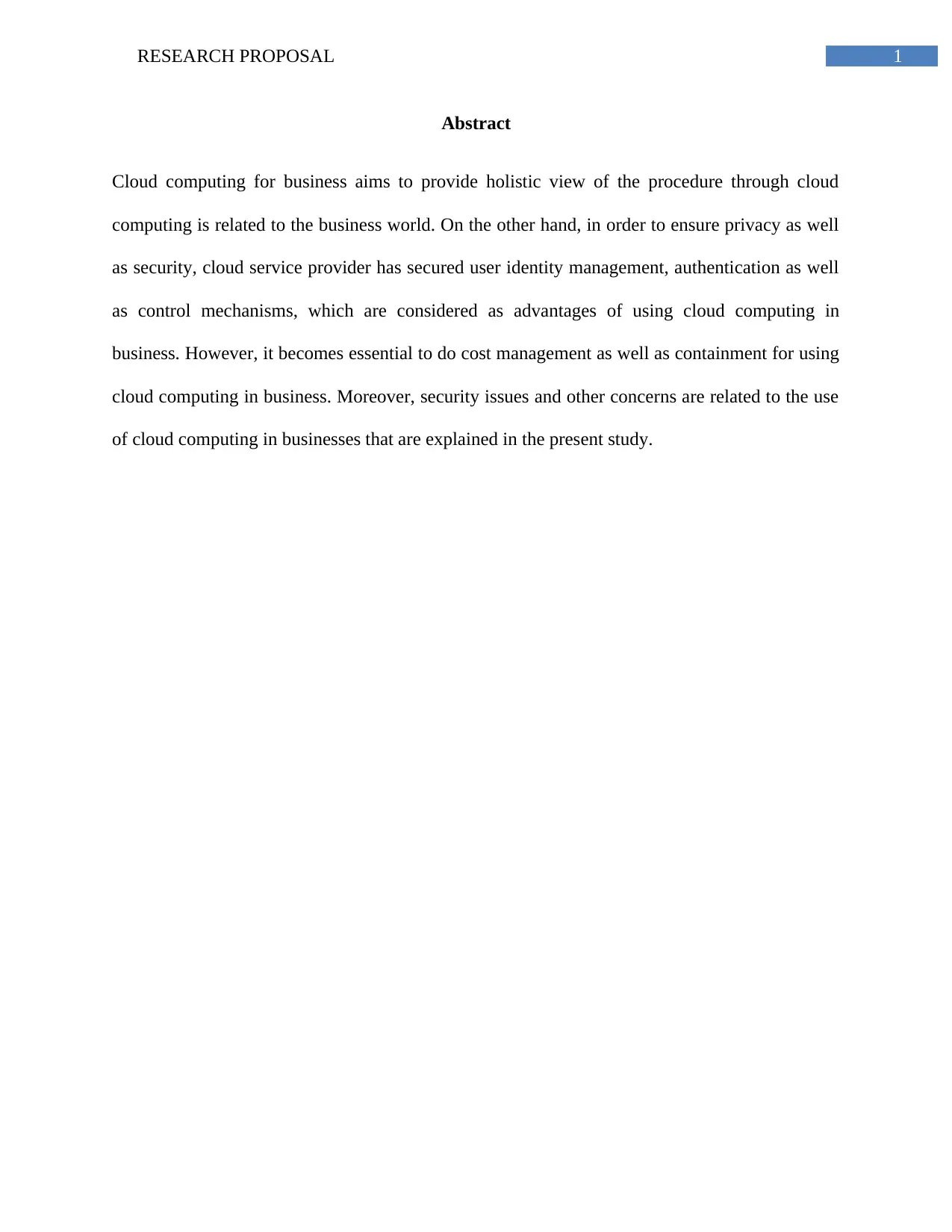
1RESEARCH PROPOSAL
Abstract
Cloud computing for business aims to provide holistic view of the procedure through cloud
computing is related to the business world. On the other hand, in order to ensure privacy as well
as security, cloud service provider has secured user identity management, authentication as well
as control mechanisms, which are considered as advantages of using cloud computing in
business. However, it becomes essential to do cost management as well as containment for using
cloud computing in business. Moreover, security issues and other concerns are related to the use
of cloud computing in businesses that are explained in the present study.
Abstract
Cloud computing for business aims to provide holistic view of the procedure through cloud
computing is related to the business world. On the other hand, in order to ensure privacy as well
as security, cloud service provider has secured user identity management, authentication as well
as control mechanisms, which are considered as advantages of using cloud computing in
business. However, it becomes essential to do cost management as well as containment for using
cloud computing in business. Moreover, security issues and other concerns are related to the use
of cloud computing in businesses that are explained in the present study.
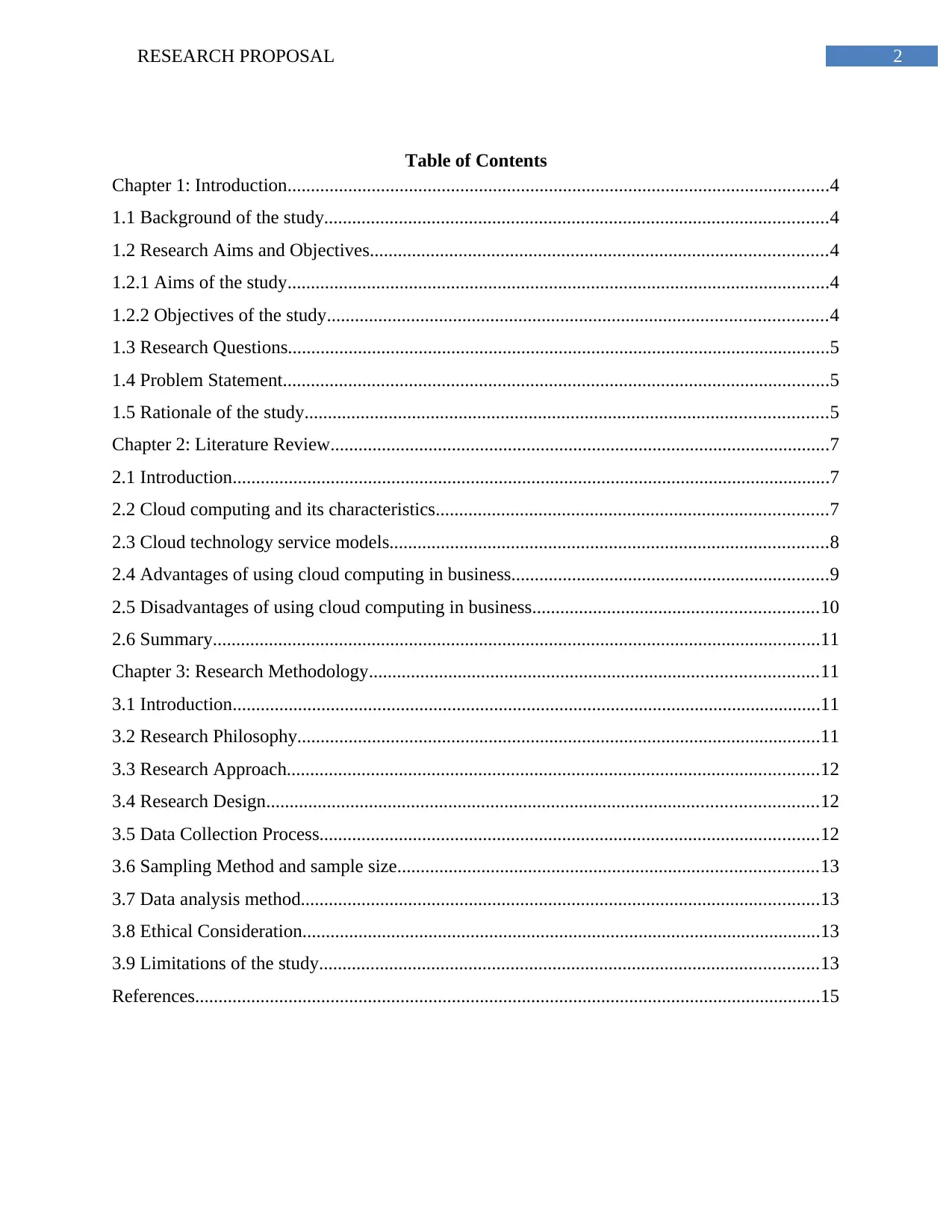
2RESEARCH PROPOSAL
Table of Contents
Chapter 1: Introduction....................................................................................................................4
1.1 Background of the study............................................................................................................4
1.2 Research Aims and Objectives..................................................................................................4
1.2.1 Aims of the study....................................................................................................................4
1.2.2 Objectives of the study...........................................................................................................4
1.3 Research Questions....................................................................................................................5
1.4 Problem Statement.....................................................................................................................5
1.5 Rationale of the study................................................................................................................5
Chapter 2: Literature Review...........................................................................................................7
2.1 Introduction................................................................................................................................7
2.2 Cloud computing and its characteristics....................................................................................7
2.3 Cloud technology service models..............................................................................................8
2.4 Advantages of using cloud computing in business....................................................................9
2.5 Disadvantages of using cloud computing in business.............................................................10
2.6 Summary..................................................................................................................................11
Chapter 3: Research Methodology................................................................................................11
3.1 Introduction..............................................................................................................................11
3.2 Research Philosophy................................................................................................................11
3.3 Research Approach..................................................................................................................12
3.4 Research Design......................................................................................................................12
3.5 Data Collection Process...........................................................................................................12
3.6 Sampling Method and sample size..........................................................................................13
3.7 Data analysis method...............................................................................................................13
3.8 Ethical Consideration...............................................................................................................13
3.9 Limitations of the study...........................................................................................................13
References......................................................................................................................................15
Table of Contents
Chapter 1: Introduction....................................................................................................................4
1.1 Background of the study............................................................................................................4
1.2 Research Aims and Objectives..................................................................................................4
1.2.1 Aims of the study....................................................................................................................4
1.2.2 Objectives of the study...........................................................................................................4
1.3 Research Questions....................................................................................................................5
1.4 Problem Statement.....................................................................................................................5
1.5 Rationale of the study................................................................................................................5
Chapter 2: Literature Review...........................................................................................................7
2.1 Introduction................................................................................................................................7
2.2 Cloud computing and its characteristics....................................................................................7
2.3 Cloud technology service models..............................................................................................8
2.4 Advantages of using cloud computing in business....................................................................9
2.5 Disadvantages of using cloud computing in business.............................................................10
2.6 Summary..................................................................................................................................11
Chapter 3: Research Methodology................................................................................................11
3.1 Introduction..............................................................................................................................11
3.2 Research Philosophy................................................................................................................11
3.3 Research Approach..................................................................................................................12
3.4 Research Design......................................................................................................................12
3.5 Data Collection Process...........................................................................................................12
3.6 Sampling Method and sample size..........................................................................................13
3.7 Data analysis method...............................................................................................................13
3.8 Ethical Consideration...............................................................................................................13
3.9 Limitations of the study...........................................................................................................13
References......................................................................................................................................15
⊘ This is a preview!⊘
Do you want full access?
Subscribe today to unlock all pages.

Trusted by 1+ million students worldwide
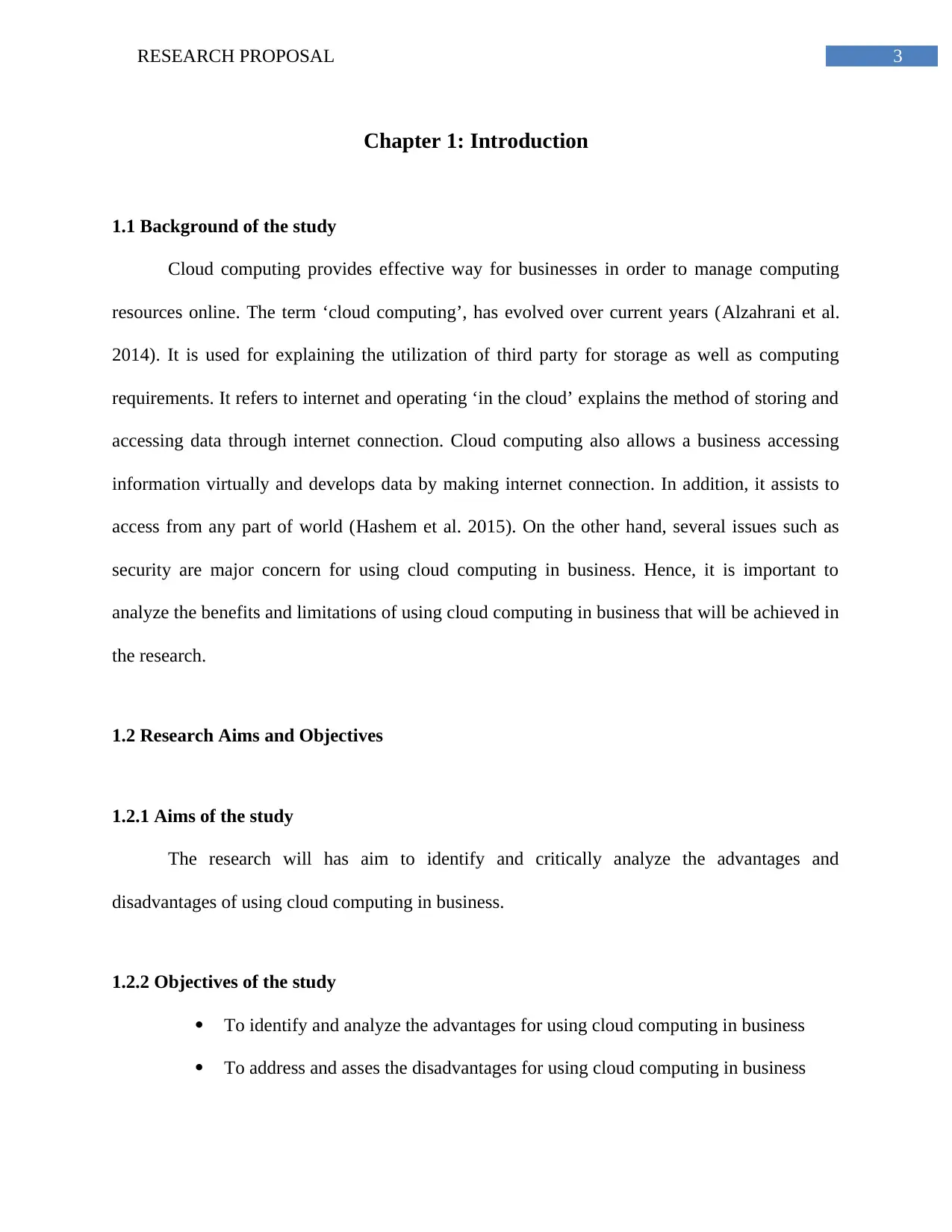
3RESEARCH PROPOSAL
Chapter 1: Introduction
1.1 Background of the study
Cloud computing provides effective way for businesses in order to manage computing
resources online. The term ‘cloud computing’, has evolved over current years (Alzahrani et al.
2014). It is used for explaining the utilization of third party for storage as well as computing
requirements. It refers to internet and operating ‘in the cloud’ explains the method of storing and
accessing data through internet connection. Cloud computing also allows a business accessing
information virtually and develops data by making internet connection. In addition, it assists to
access from any part of world (Hashem et al. 2015). On the other hand, several issues such as
security are major concern for using cloud computing in business. Hence, it is important to
analyze the benefits and limitations of using cloud computing in business that will be achieved in
the research.
1.2 Research Aims and Objectives
1.2.1 Aims of the study
The research will has aim to identify and critically analyze the advantages and
disadvantages of using cloud computing in business.
1.2.2 Objectives of the study
To identify and analyze the advantages for using cloud computing in business
To address and asses the disadvantages for using cloud computing in business
Chapter 1: Introduction
1.1 Background of the study
Cloud computing provides effective way for businesses in order to manage computing
resources online. The term ‘cloud computing’, has evolved over current years (Alzahrani et al.
2014). It is used for explaining the utilization of third party for storage as well as computing
requirements. It refers to internet and operating ‘in the cloud’ explains the method of storing and
accessing data through internet connection. Cloud computing also allows a business accessing
information virtually and develops data by making internet connection. In addition, it assists to
access from any part of world (Hashem et al. 2015). On the other hand, several issues such as
security are major concern for using cloud computing in business. Hence, it is important to
analyze the benefits and limitations of using cloud computing in business that will be achieved in
the research.
1.2 Research Aims and Objectives
1.2.1 Aims of the study
The research will has aim to identify and critically analyze the advantages and
disadvantages of using cloud computing in business.
1.2.2 Objectives of the study
To identify and analyze the advantages for using cloud computing in business
To address and asses the disadvantages for using cloud computing in business
Paraphrase This Document
Need a fresh take? Get an instant paraphrase of this document with our AI Paraphraser
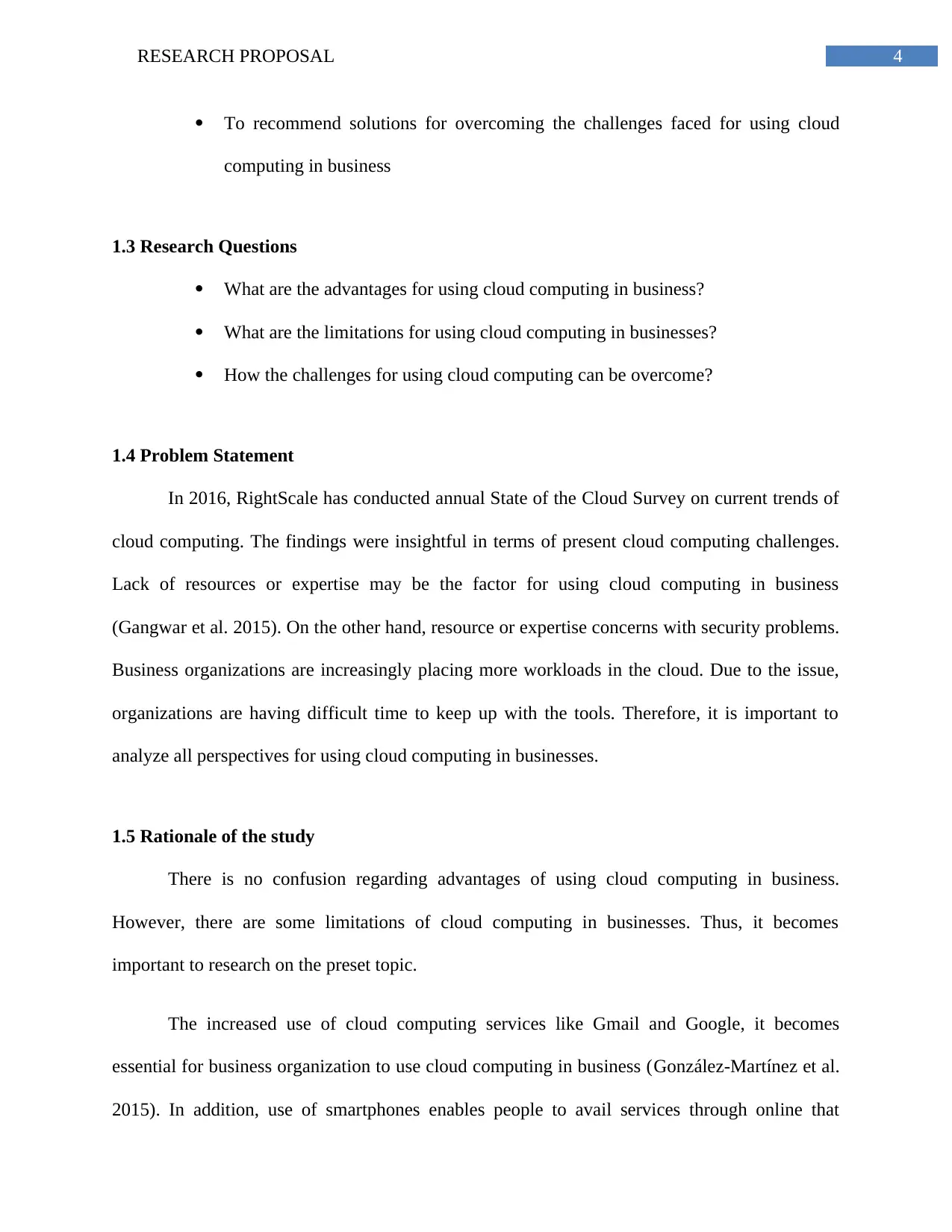
4RESEARCH PROPOSAL
To recommend solutions for overcoming the challenges faced for using cloud
computing in business
1.3 Research Questions
What are the advantages for using cloud computing in business?
What are the limitations for using cloud computing in businesses?
How the challenges for using cloud computing can be overcome?
1.4 Problem Statement
In 2016, RightScale has conducted annual State of the Cloud Survey on current trends of
cloud computing. The findings were insightful in terms of present cloud computing challenges.
Lack of resources or expertise may be the factor for using cloud computing in business
(Gangwar et al. 2015). On the other hand, resource or expertise concerns with security problems.
Business organizations are increasingly placing more workloads in the cloud. Due to the issue,
organizations are having difficult time to keep up with the tools. Therefore, it is important to
analyze all perspectives for using cloud computing in businesses.
1.5 Rationale of the study
There is no confusion regarding advantages of using cloud computing in business.
However, there are some limitations of cloud computing in businesses. Thus, it becomes
important to research on the preset topic.
The increased use of cloud computing services like Gmail and Google, it becomes
essential for business organization to use cloud computing in business (González-Martínez et al.
2015). In addition, use of smartphones enables people to avail services through online that
To recommend solutions for overcoming the challenges faced for using cloud
computing in business
1.3 Research Questions
What are the advantages for using cloud computing in business?
What are the limitations for using cloud computing in businesses?
How the challenges for using cloud computing can be overcome?
1.4 Problem Statement
In 2016, RightScale has conducted annual State of the Cloud Survey on current trends of
cloud computing. The findings were insightful in terms of present cloud computing challenges.
Lack of resources or expertise may be the factor for using cloud computing in business
(Gangwar et al. 2015). On the other hand, resource or expertise concerns with security problems.
Business organizations are increasingly placing more workloads in the cloud. Due to the issue,
organizations are having difficult time to keep up with the tools. Therefore, it is important to
analyze all perspectives for using cloud computing in businesses.
1.5 Rationale of the study
There is no confusion regarding advantages of using cloud computing in business.
However, there are some limitations of cloud computing in businesses. Thus, it becomes
important to research on the preset topic.
The increased use of cloud computing services like Gmail and Google, it becomes
essential for business organization to use cloud computing in business (González-Martínez et al.
2015). In addition, use of smartphones enables people to avail services through online that
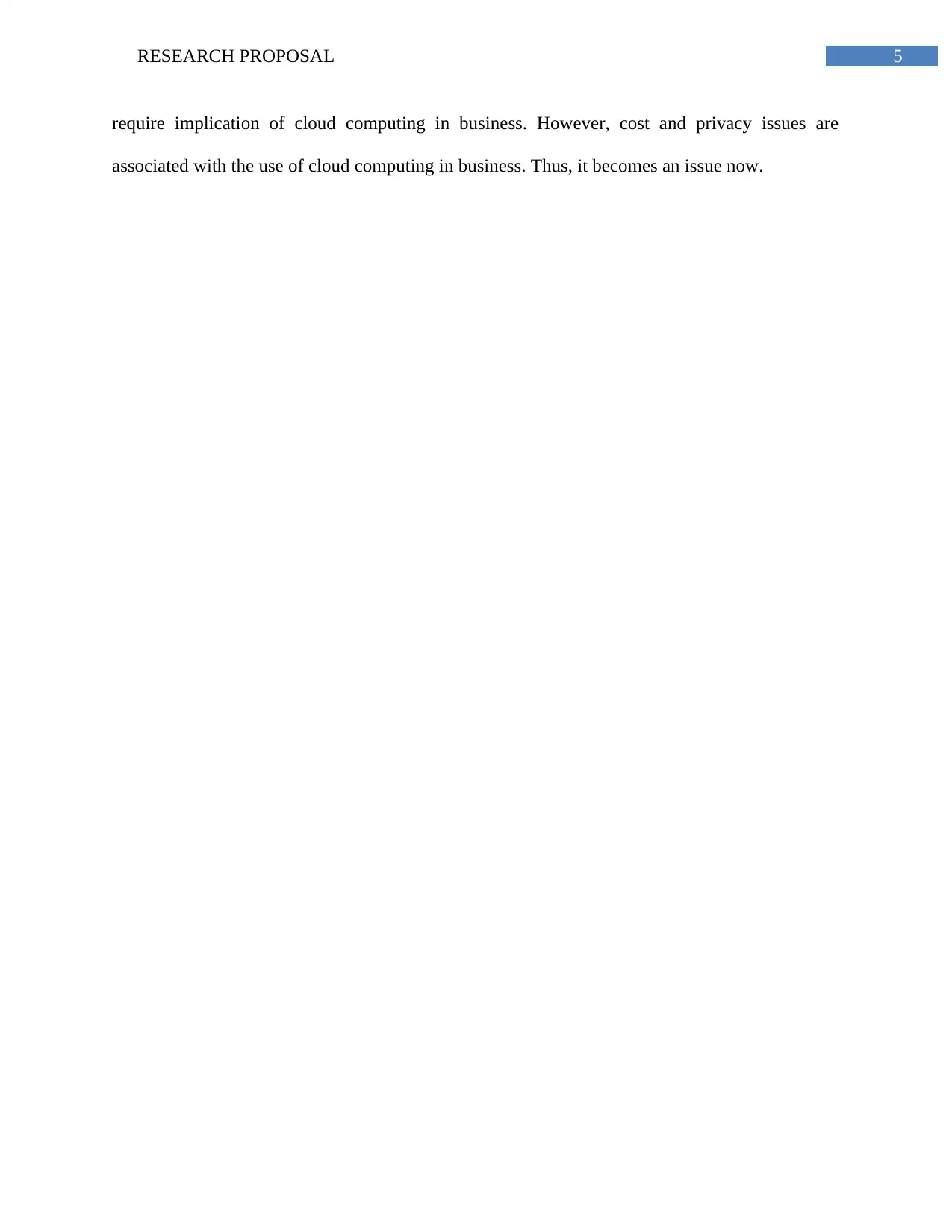
5RESEARCH PROPOSAL
require implication of cloud computing in business. However, cost and privacy issues are
associated with the use of cloud computing in business. Thus, it becomes an issue now.
require implication of cloud computing in business. However, cost and privacy issues are
associated with the use of cloud computing in business. Thus, it becomes an issue now.
⊘ This is a preview!⊘
Do you want full access?
Subscribe today to unlock all pages.

Trusted by 1+ million students worldwide
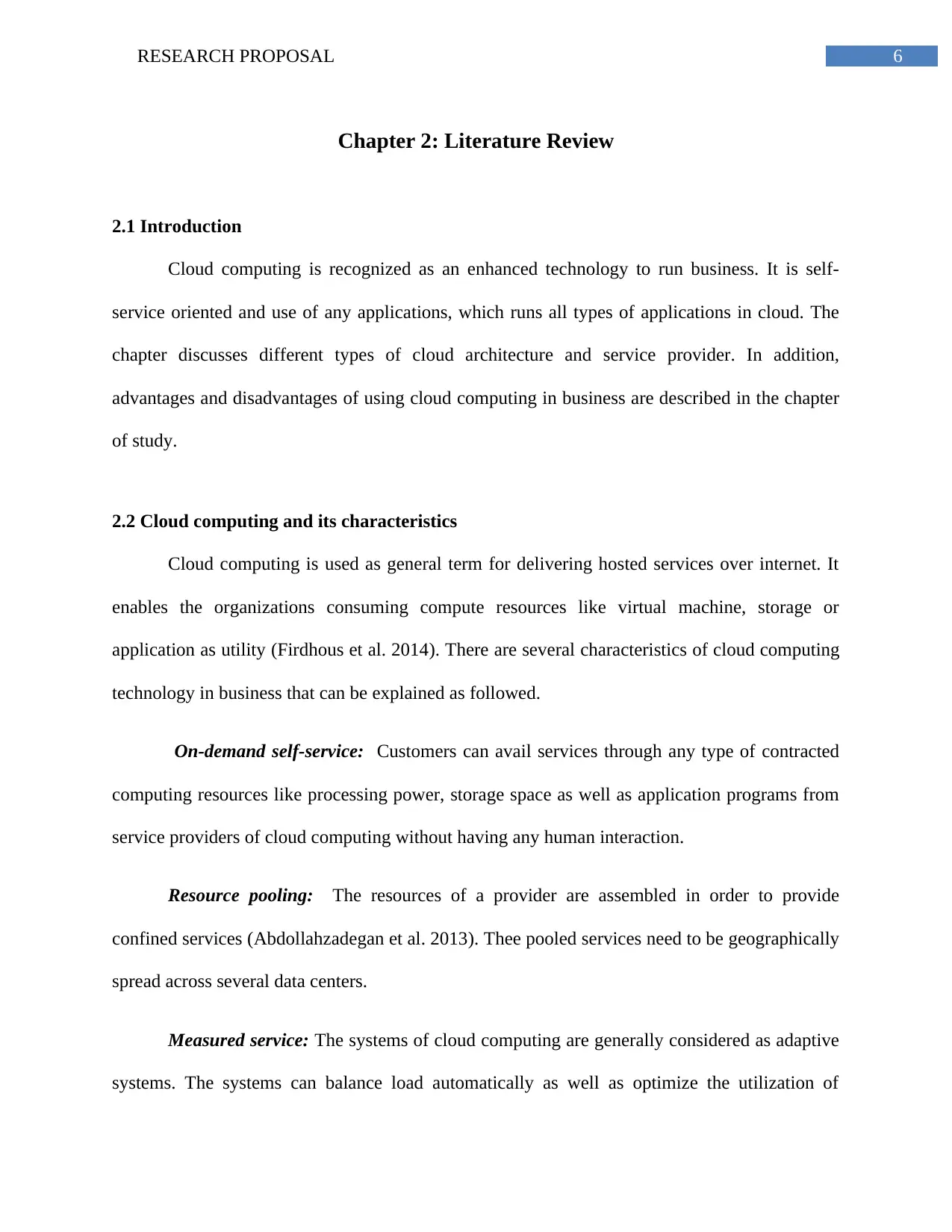
6RESEARCH PROPOSAL
Chapter 2: Literature Review
2.1 Introduction
Cloud computing is recognized as an enhanced technology to run business. It is self-
service oriented and use of any applications, which runs all types of applications in cloud. The
chapter discusses different types of cloud architecture and service provider. In addition,
advantages and disadvantages of using cloud computing in business are described in the chapter
of study.
2.2 Cloud computing and its characteristics
Cloud computing is used as general term for delivering hosted services over internet. It
enables the organizations consuming compute resources like virtual machine, storage or
application as utility (Firdhous et al. 2014). There are several characteristics of cloud computing
technology in business that can be explained as followed.
On-demand self-service: Customers can avail services through any type of contracted
computing resources like processing power, storage space as well as application programs from
service providers of cloud computing without having any human interaction.
Resource pooling: The resources of a provider are assembled in order to provide
confined services (Abdollahzadegan et al. 2013). Thee pooled services need to be geographically
spread across several data centers.
Measured service: The systems of cloud computing are generally considered as adaptive
systems. The systems can balance load automatically as well as optimize the utilization of
Chapter 2: Literature Review
2.1 Introduction
Cloud computing is recognized as an enhanced technology to run business. It is self-
service oriented and use of any applications, which runs all types of applications in cloud. The
chapter discusses different types of cloud architecture and service provider. In addition,
advantages and disadvantages of using cloud computing in business are described in the chapter
of study.
2.2 Cloud computing and its characteristics
Cloud computing is used as general term for delivering hosted services over internet. It
enables the organizations consuming compute resources like virtual machine, storage or
application as utility (Firdhous et al. 2014). There are several characteristics of cloud computing
technology in business that can be explained as followed.
On-demand self-service: Customers can avail services through any type of contracted
computing resources like processing power, storage space as well as application programs from
service providers of cloud computing without having any human interaction.
Resource pooling: The resources of a provider are assembled in order to provide
confined services (Abdollahzadegan et al. 2013). Thee pooled services need to be geographically
spread across several data centers.
Measured service: The systems of cloud computing are generally considered as adaptive
systems. The systems can balance load automatically as well as optimize the utilization of
Paraphrase This Document
Need a fresh take? Get an instant paraphrase of this document with our AI Paraphraser
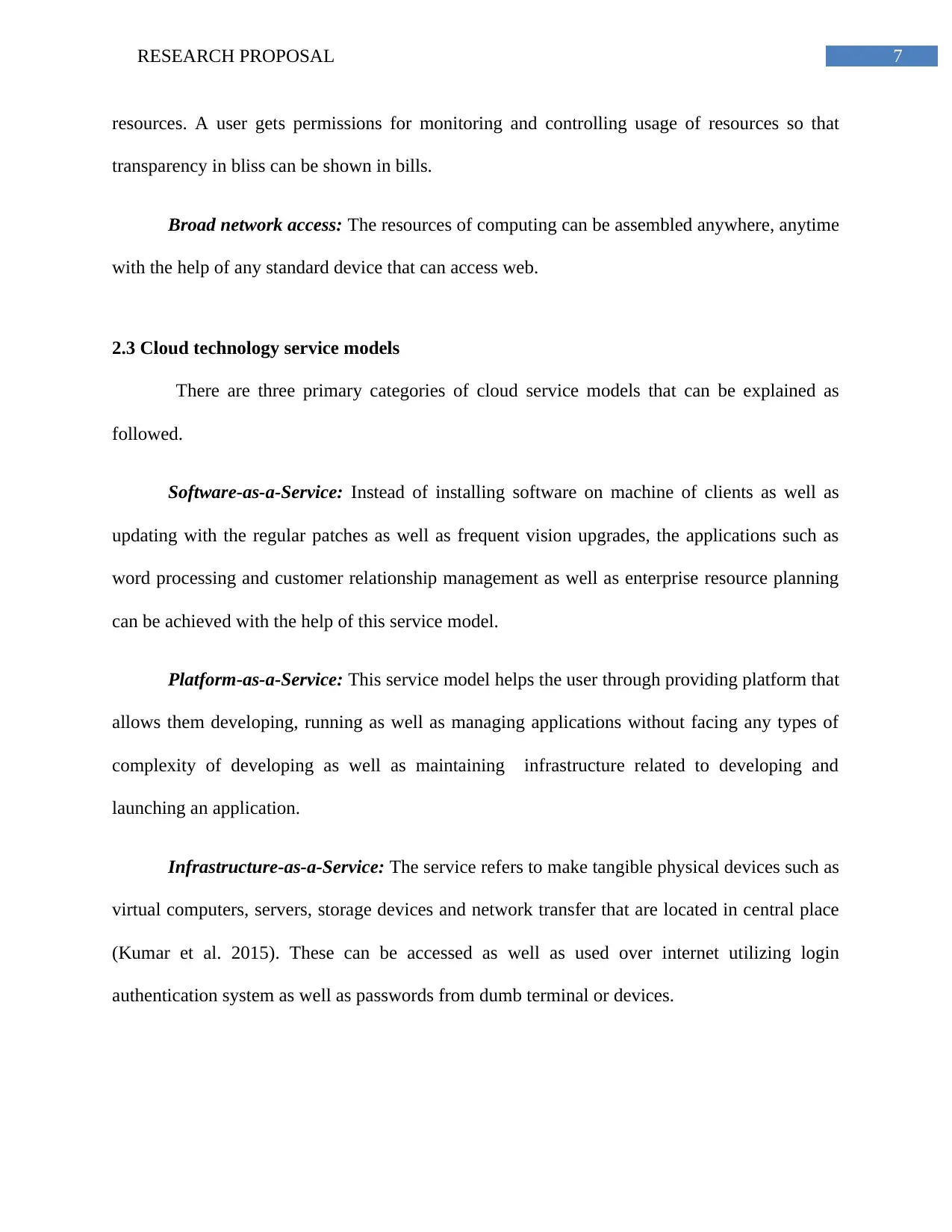
7RESEARCH PROPOSAL
resources. A user gets permissions for monitoring and controlling usage of resources so that
transparency in bliss can be shown in bills.
Broad network access: The resources of computing can be assembled anywhere, anytime
with the help of any standard device that can access web.
2.3 Cloud technology service models
There are three primary categories of cloud service models that can be explained as
followed.
Software-as-a-Service: Instead of installing software on machine of clients as well as
updating with the regular patches as well as frequent vision upgrades, the applications such as
word processing and customer relationship management as well as enterprise resource planning
can be achieved with the help of this service model.
Platform-as-a-Service: This service model helps the user through providing platform that
allows them developing, running as well as managing applications without facing any types of
complexity of developing as well as maintaining infrastructure related to developing and
launching an application.
Infrastructure-as-a-Service: The service refers to make tangible physical devices such as
virtual computers, servers, storage devices and network transfer that are located in central place
(Kumar et al. 2015). These can be accessed as well as used over internet utilizing login
authentication system as well as passwords from dumb terminal or devices.
resources. A user gets permissions for monitoring and controlling usage of resources so that
transparency in bliss can be shown in bills.
Broad network access: The resources of computing can be assembled anywhere, anytime
with the help of any standard device that can access web.
2.3 Cloud technology service models
There are three primary categories of cloud service models that can be explained as
followed.
Software-as-a-Service: Instead of installing software on machine of clients as well as
updating with the regular patches as well as frequent vision upgrades, the applications such as
word processing and customer relationship management as well as enterprise resource planning
can be achieved with the help of this service model.
Platform-as-a-Service: This service model helps the user through providing platform that
allows them developing, running as well as managing applications without facing any types of
complexity of developing as well as maintaining infrastructure related to developing and
launching an application.
Infrastructure-as-a-Service: The service refers to make tangible physical devices such as
virtual computers, servers, storage devices and network transfer that are located in central place
(Kumar et al. 2015). These can be accessed as well as used over internet utilizing login
authentication system as well as passwords from dumb terminal or devices.
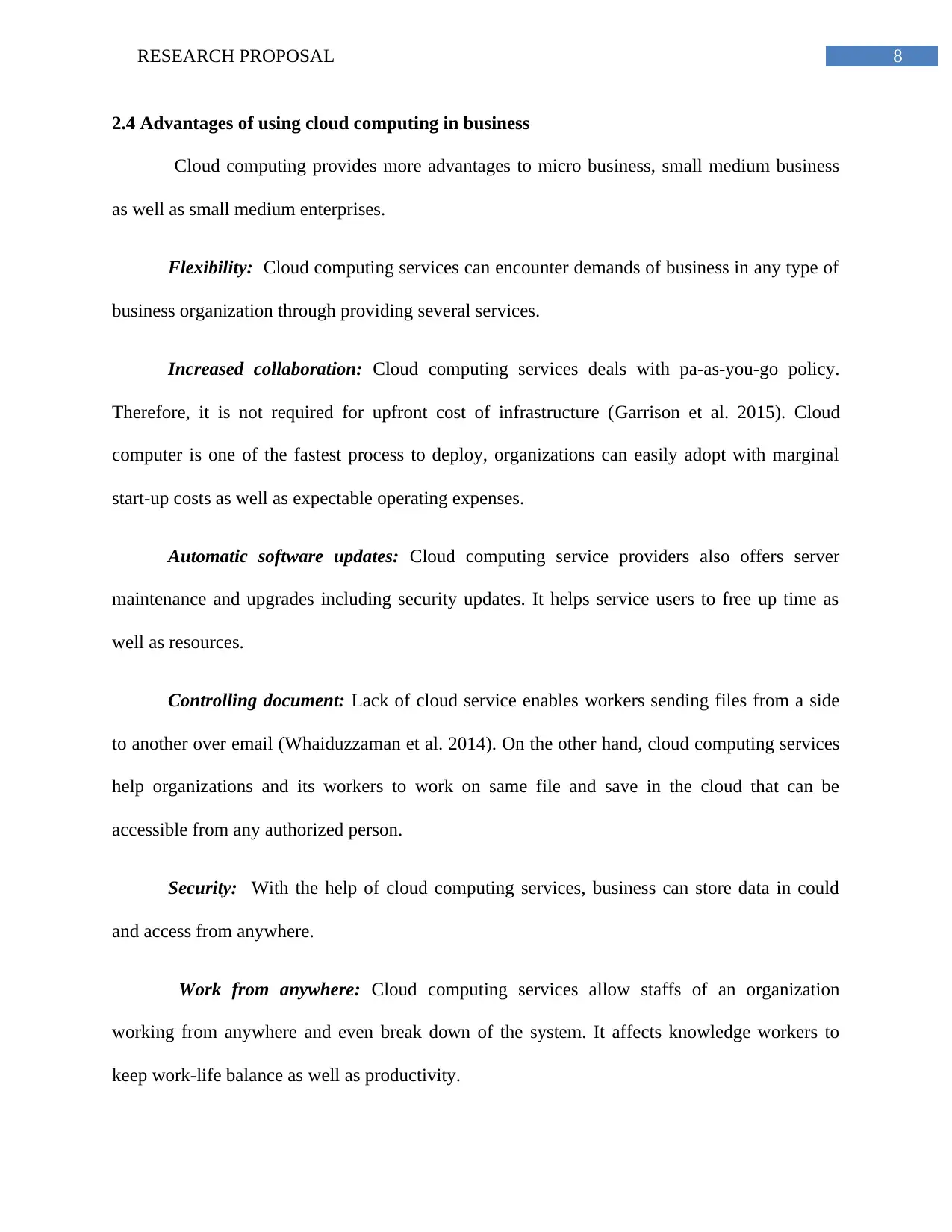
8RESEARCH PROPOSAL
2.4 Advantages of using cloud computing in business
Cloud computing provides more advantages to micro business, small medium business
as well as small medium enterprises.
Flexibility: Cloud computing services can encounter demands of business in any type of
business organization through providing several services.
Increased collaboration: Cloud computing services deals with pa-as-you-go policy.
Therefore, it is not required for upfront cost of infrastructure (Garrison et al. 2015). Cloud
computer is one of the fastest process to deploy, organizations can easily adopt with marginal
start-up costs as well as expectable operating expenses.
Automatic software updates: Cloud computing service providers also offers server
maintenance and upgrades including security updates. It helps service users to free up time as
well as resources.
Controlling document: Lack of cloud service enables workers sending files from a side
to another over email (Whaiduzzaman et al. 2014). On the other hand, cloud computing services
help organizations and its workers to work on same file and save in the cloud that can be
accessible from any authorized person.
Security: With the help of cloud computing services, business can store data in could
and access from anywhere.
Work from anywhere: Cloud computing services allow staffs of an organization
working from anywhere and even break down of the system. It affects knowledge workers to
keep work-life balance as well as productivity.
2.4 Advantages of using cloud computing in business
Cloud computing provides more advantages to micro business, small medium business
as well as small medium enterprises.
Flexibility: Cloud computing services can encounter demands of business in any type of
business organization through providing several services.
Increased collaboration: Cloud computing services deals with pa-as-you-go policy.
Therefore, it is not required for upfront cost of infrastructure (Garrison et al. 2015). Cloud
computer is one of the fastest process to deploy, organizations can easily adopt with marginal
start-up costs as well as expectable operating expenses.
Automatic software updates: Cloud computing service providers also offers server
maintenance and upgrades including security updates. It helps service users to free up time as
well as resources.
Controlling document: Lack of cloud service enables workers sending files from a side
to another over email (Whaiduzzaman et al. 2014). On the other hand, cloud computing services
help organizations and its workers to work on same file and save in the cloud that can be
accessible from any authorized person.
Security: With the help of cloud computing services, business can store data in could
and access from anywhere.
Work from anywhere: Cloud computing services allow staffs of an organization
working from anywhere and even break down of the system. It affects knowledge workers to
keep work-life balance as well as productivity.
⊘ This is a preview!⊘
Do you want full access?
Subscribe today to unlock all pages.

Trusted by 1+ million students worldwide
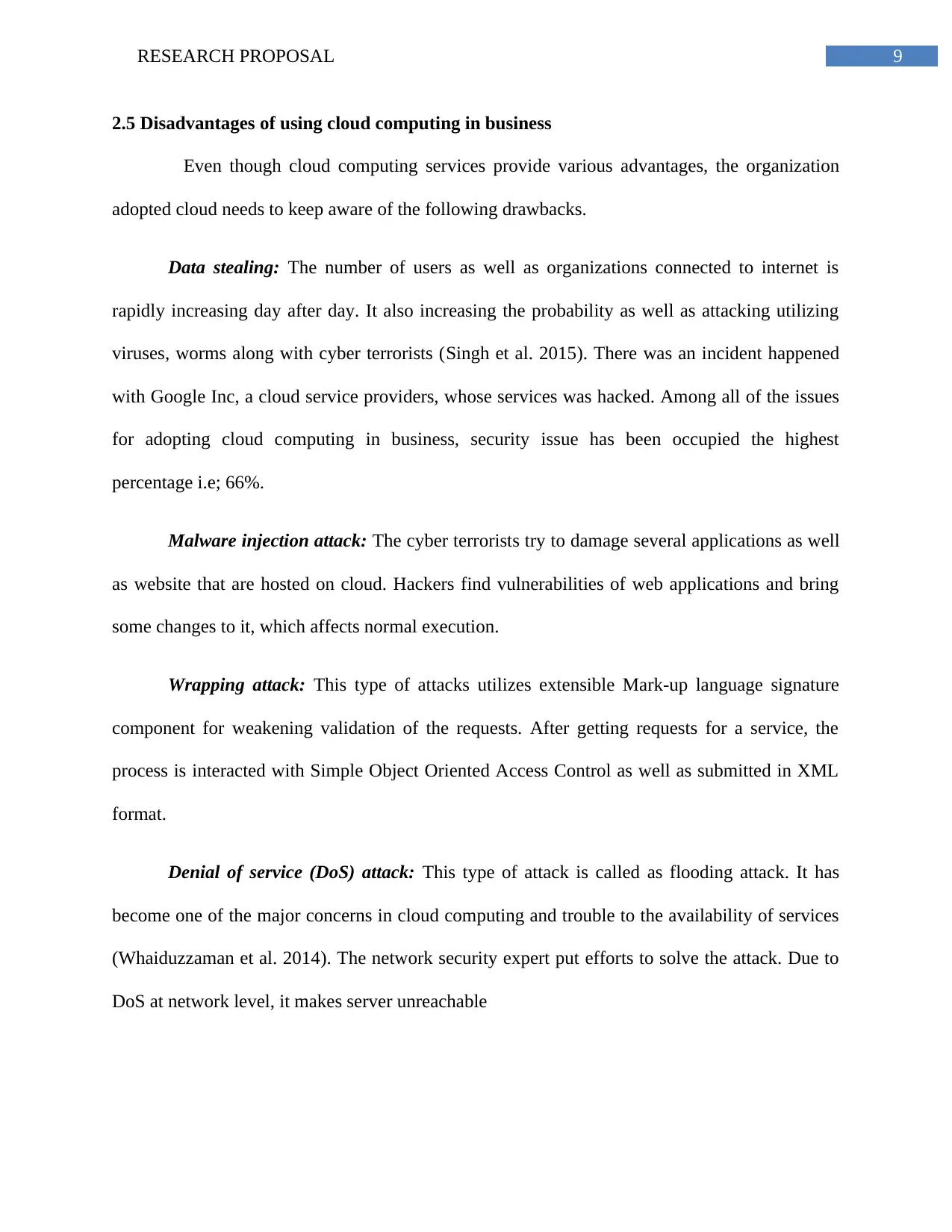
9RESEARCH PROPOSAL
2.5 Disadvantages of using cloud computing in business
Even though cloud computing services provide various advantages, the organization
adopted cloud needs to keep aware of the following drawbacks.
Data stealing: The number of users as well as organizations connected to internet is
rapidly increasing day after day. It also increasing the probability as well as attacking utilizing
viruses, worms along with cyber terrorists (Singh et al. 2015). There was an incident happened
with Google Inc, a cloud service providers, whose services was hacked. Among all of the issues
for adopting cloud computing in business, security issue has been occupied the highest
percentage i.e; 66%.
Malware injection attack: The cyber terrorists try to damage several applications as well
as website that are hosted on cloud. Hackers find vulnerabilities of web applications and bring
some changes to it, which affects normal execution.
Wrapping attack: This type of attacks utilizes extensible Mark-up language signature
component for weakening validation of the requests. After getting requests for a service, the
process is interacted with Simple Object Oriented Access Control as well as submitted in XML
format.
Denial of service (DoS) attack: This type of attack is called as flooding attack. It has
become one of the major concerns in cloud computing and trouble to the availability of services
(Whaiduzzaman et al. 2014). The network security expert put efforts to solve the attack. Due to
DoS at network level, it makes server unreachable
2.5 Disadvantages of using cloud computing in business
Even though cloud computing services provide various advantages, the organization
adopted cloud needs to keep aware of the following drawbacks.
Data stealing: The number of users as well as organizations connected to internet is
rapidly increasing day after day. It also increasing the probability as well as attacking utilizing
viruses, worms along with cyber terrorists (Singh et al. 2015). There was an incident happened
with Google Inc, a cloud service providers, whose services was hacked. Among all of the issues
for adopting cloud computing in business, security issue has been occupied the highest
percentage i.e; 66%.
Malware injection attack: The cyber terrorists try to damage several applications as well
as website that are hosted on cloud. Hackers find vulnerabilities of web applications and bring
some changes to it, which affects normal execution.
Wrapping attack: This type of attacks utilizes extensible Mark-up language signature
component for weakening validation of the requests. After getting requests for a service, the
process is interacted with Simple Object Oriented Access Control as well as submitted in XML
format.
Denial of service (DoS) attack: This type of attack is called as flooding attack. It has
become one of the major concerns in cloud computing and trouble to the availability of services
(Whaiduzzaman et al. 2014). The network security expert put efforts to solve the attack. Due to
DoS at network level, it makes server unreachable
Paraphrase This Document
Need a fresh take? Get an instant paraphrase of this document with our AI Paraphraser
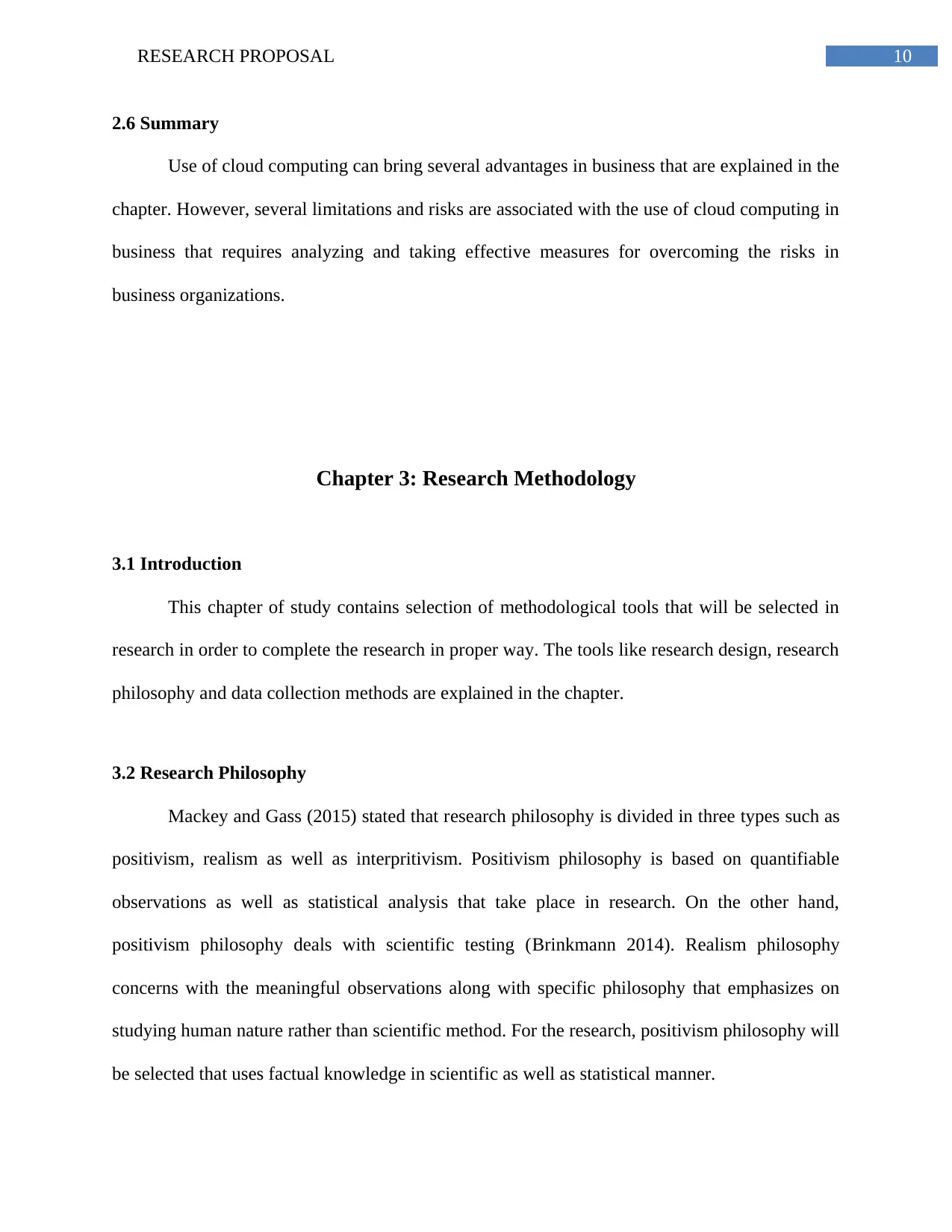
10RESEARCH PROPOSAL
2.6 Summary
Use of cloud computing can bring several advantages in business that are explained in the
chapter. However, several limitations and risks are associated with the use of cloud computing in
business that requires analyzing and taking effective measures for overcoming the risks in
business organizations.
Chapter 3: Research Methodology
3.1 Introduction
This chapter of study contains selection of methodological tools that will be selected in
research in order to complete the research in proper way. The tools like research design, research
philosophy and data collection methods are explained in the chapter.
3.2 Research Philosophy
Mackey and Gass (2015) stated that research philosophy is divided in three types such as
positivism, realism as well as interpritivism. Positivism philosophy is based on quantifiable
observations as well as statistical analysis that take place in research. On the other hand,
positivism philosophy deals with scientific testing (Brinkmann 2014). Realism philosophy
concerns with the meaningful observations along with specific philosophy that emphasizes on
studying human nature rather than scientific method. For the research, positivism philosophy will
be selected that uses factual knowledge in scientific as well as statistical manner.
2.6 Summary
Use of cloud computing can bring several advantages in business that are explained in the
chapter. However, several limitations and risks are associated with the use of cloud computing in
business that requires analyzing and taking effective measures for overcoming the risks in
business organizations.
Chapter 3: Research Methodology
3.1 Introduction
This chapter of study contains selection of methodological tools that will be selected in
research in order to complete the research in proper way. The tools like research design, research
philosophy and data collection methods are explained in the chapter.
3.2 Research Philosophy
Mackey and Gass (2015) stated that research philosophy is divided in three types such as
positivism, realism as well as interpritivism. Positivism philosophy is based on quantifiable
observations as well as statistical analysis that take place in research. On the other hand,
positivism philosophy deals with scientific testing (Brinkmann 2014). Realism philosophy
concerns with the meaningful observations along with specific philosophy that emphasizes on
studying human nature rather than scientific method. For the research, positivism philosophy will
be selected that uses factual knowledge in scientific as well as statistical manner.
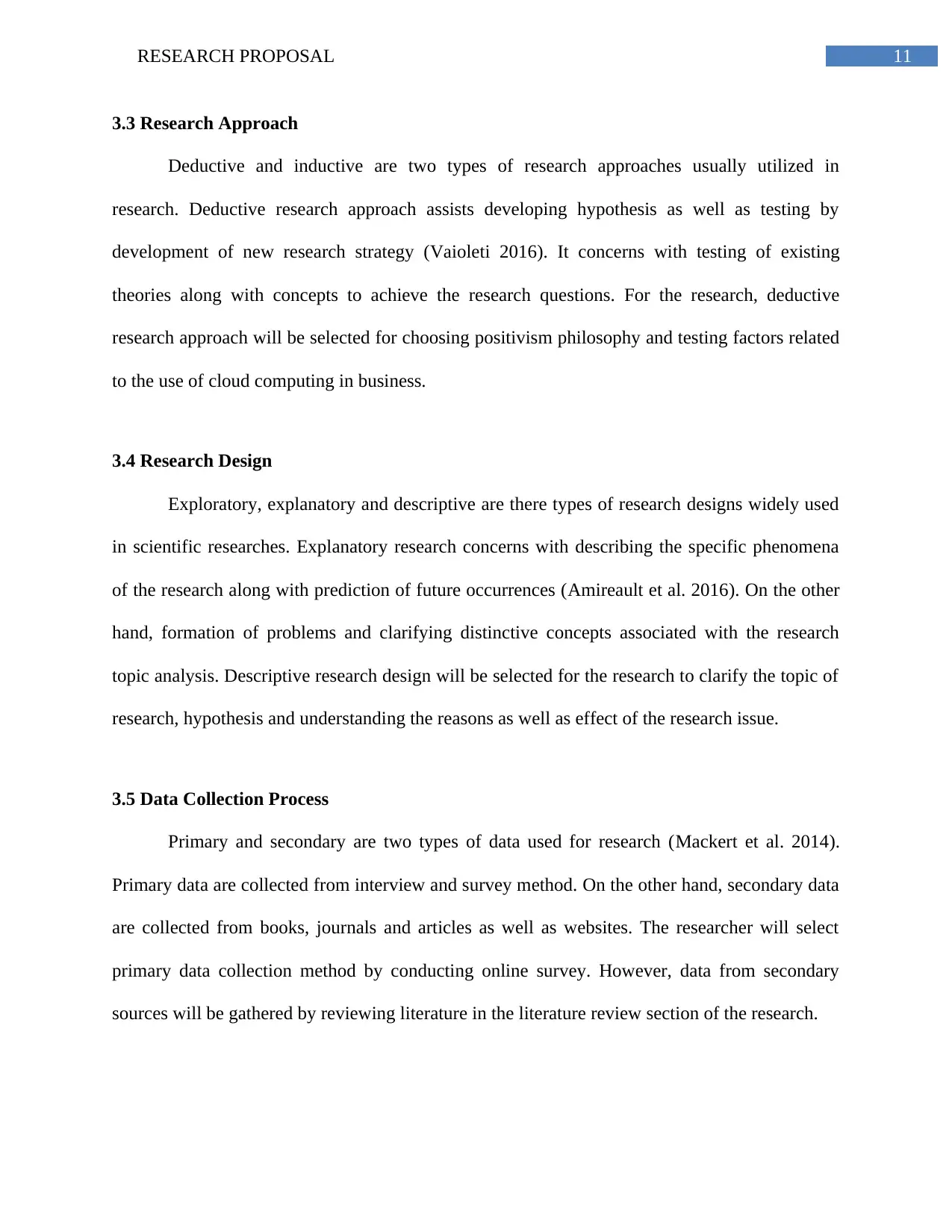
11RESEARCH PROPOSAL
3.3 Research Approach
Deductive and inductive are two types of research approaches usually utilized in
research. Deductive research approach assists developing hypothesis as well as testing by
development of new research strategy (Vaioleti 2016). It concerns with testing of existing
theories along with concepts to achieve the research questions. For the research, deductive
research approach will be selected for choosing positivism philosophy and testing factors related
to the use of cloud computing in business.
3.4 Research Design
Exploratory, explanatory and descriptive are there types of research designs widely used
in scientific researches. Explanatory research concerns with describing the specific phenomena
of the research along with prediction of future occurrences (Amireault et al. 2016). On the other
hand, formation of problems and clarifying distinctive concepts associated with the research
topic analysis. Descriptive research design will be selected for the research to clarify the topic of
research, hypothesis and understanding the reasons as well as effect of the research issue.
3.5 Data Collection Process
Primary and secondary are two types of data used for research (Mackert et al. 2014).
Primary data are collected from interview and survey method. On the other hand, secondary data
are collected from books, journals and articles as well as websites. The researcher will select
primary data collection method by conducting online survey. However, data from secondary
sources will be gathered by reviewing literature in the literature review section of the research.
3.3 Research Approach
Deductive and inductive are two types of research approaches usually utilized in
research. Deductive research approach assists developing hypothesis as well as testing by
development of new research strategy (Vaioleti 2016). It concerns with testing of existing
theories along with concepts to achieve the research questions. For the research, deductive
research approach will be selected for choosing positivism philosophy and testing factors related
to the use of cloud computing in business.
3.4 Research Design
Exploratory, explanatory and descriptive are there types of research designs widely used
in scientific researches. Explanatory research concerns with describing the specific phenomena
of the research along with prediction of future occurrences (Amireault et al. 2016). On the other
hand, formation of problems and clarifying distinctive concepts associated with the research
topic analysis. Descriptive research design will be selected for the research to clarify the topic of
research, hypothesis and understanding the reasons as well as effect of the research issue.
3.5 Data Collection Process
Primary and secondary are two types of data used for research (Mackert et al. 2014).
Primary data are collected from interview and survey method. On the other hand, secondary data
are collected from books, journals and articles as well as websites. The researcher will select
primary data collection method by conducting online survey. However, data from secondary
sources will be gathered by reviewing literature in the literature review section of the research.
⊘ This is a preview!⊘
Do you want full access?
Subscribe today to unlock all pages.

Trusted by 1+ million students worldwide
1 out of 17
Related Documents
Your All-in-One AI-Powered Toolkit for Academic Success.
+13062052269
info@desklib.com
Available 24*7 on WhatsApp / Email
![[object Object]](/_next/static/media/star-bottom.7253800d.svg)
Unlock your academic potential
Copyright © 2020–2025 A2Z Services. All Rights Reserved. Developed and managed by ZUCOL.





